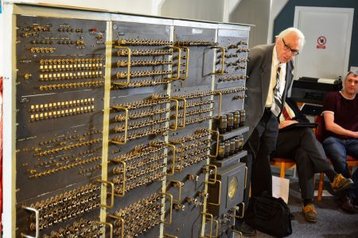Dr. Raymond Bird, the developer of the Hollerith Electronic Computer (HEC), has passed away at the age of 101.
Announced by The National Museum of Computing (TNMOC) via a post to X, the museum said: "We are saddened to hear of the passing of Dr Raymond “Dickie” Bird, the designer of the HEC1, at the remarkable age of 101. His pioneering work helped shape Britain’s first mass-produced business computer, leaving an enduring legacy."
Prior to working on the HEC, Bird was a technical officer at the Royal Air Force.
The HEC1 was prototyped in 1951 and publicly shown in 1953. According to TNMOC, the computer was the first computer to be installed in many countries, including India, New Zealand, and East Africa.
The HEC was commissioned by the British Tabulating Machine Company (BTM).
Bird told TNMOC in 2016: "BTM was one of Britain’s largest suppliers of pre-computing punch-card systems and the company realized that computing was the company’s future. BTM had been approached by Professor Andrew Booth of Birkbeck College, London, who needed input and output technologies – punch cards – for a computer he was designing. A deal was struck and I was sent to make copies of Booth’s computer design.
“Previously I had only worked with analog technologies and I was mesmerized by seeing this digital door opening before me. It was my job to get something working. I did the things that Booth thought were trivial – I engineered it.
“Unknown to me at the time, the people working in the room next to me were the engineers who had made the wartime code-breaking Bombe machine designed by Alan Turing and deployed at Bletchley Park. In the early 1950s, they were continuing to develop machines for BTM.”
The HEC was 1.5m tall and around 3m wide, featuring approximately 1,000 valves and its memory system was a magnetic drum that rotated at 3,000 rpm with 32 tracks and 16 words per track for around 2Kbytes, and included extra I/O interfaces for punch card equipment.
While described as mass-produced, a subsequent iteration - HEC 2M - sold around seven or eight systems, and the HEC4 is thought to have sold more than 100 systems.
BTM merged with Powers-Samas in 1959 and was renamed International Computers and Tabulators (ICT).
Dr. Bird later went on to work on the ICT 1301 again with Professor Booth, which was the successor to HEC4 and marketed as the ICT 1201 following the merger. The ICT 1301 was, according to Bird, "more complicated than anything yet undertaken" and required a larger team.
The ICT 1301 introduced storage on magnetic tape for which Bird designed a system of error detection and correction to resolve synchronization issues. Around 200 ICT 1301 systems were sold.
In a report from The Register, which was the first to cover the passing of Dr. Bird, it is noted that his work can be seen in the 1961 US Patent 2970765A for a "data translating apparatus."
In a post on TNMOC, Bird is described as "the genius who struck twice."
DCD sends its condolences to Dr. Bird's family and friends.

